Paper Menu >>
Journal Menu >>
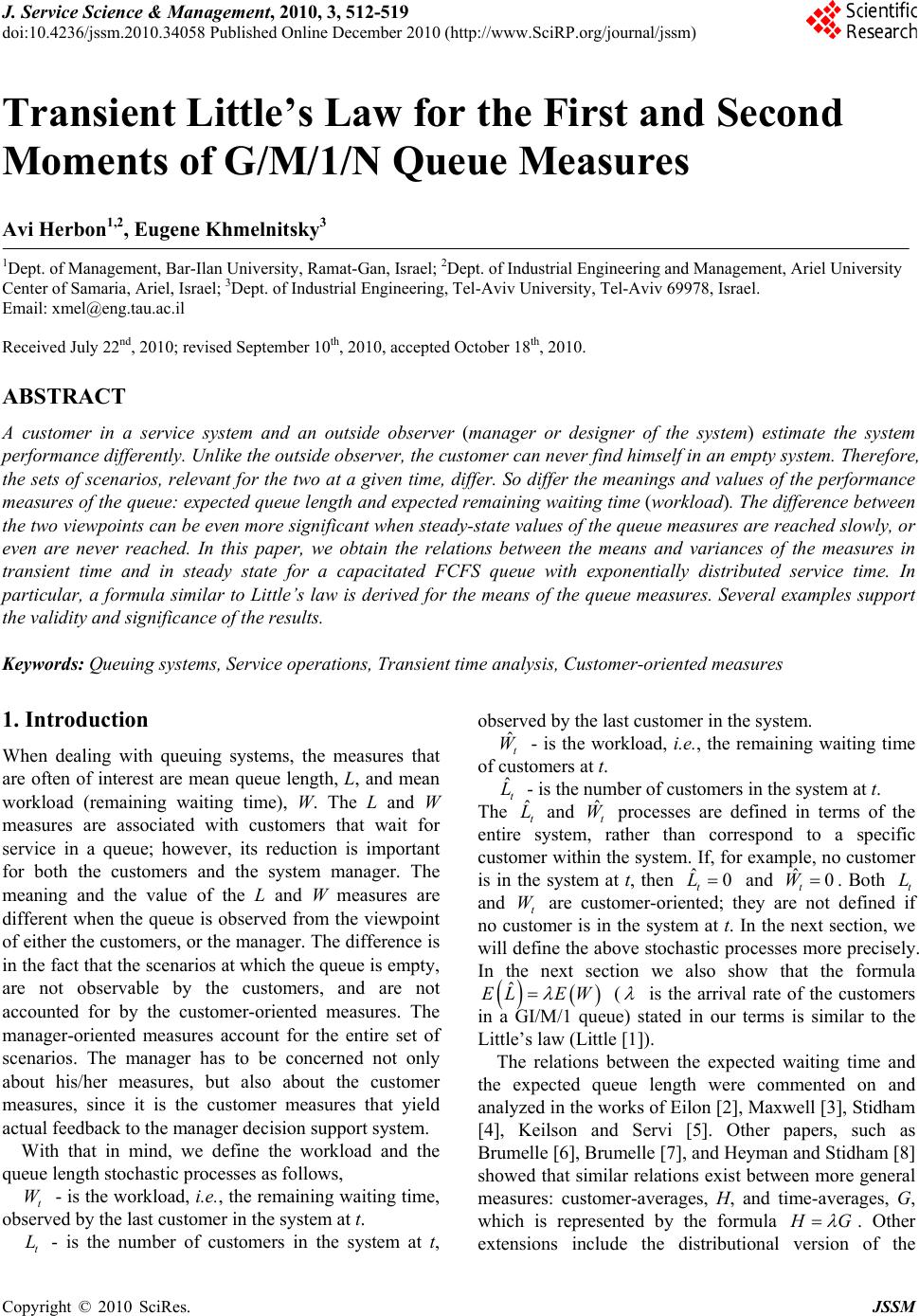 J. Service Science & Management, 2010, 3, 512-519 doi:10.4236/jssm.2010.34058 Published Online December 2010 (http://www.SciRP.org/journal/jssm) Copyright © 2010 SciRes. JSSM Transient Little’s Law for the First and Second Moments of G/M/1/N Queue Measures Avi Herbon1,2, Eugene Khmelnitsky3 1Dept. of Management, Bar-Ilan University, Ramat-Gan, Israel; 2Dept. of Industrial Engineering and Management, Ariel University Center of Samaria, Ariel, Israel; 3Dept. of Industrial Engineering, Tel-Aviv University, Tel-Aviv 69978, Israel. Email: xmel@eng.tau.ac.il Received July 22nd, 2010; revised September 10th, 2010, accepted October 18th, 2010. ABSTRACT A customer in a service system and an outside observer (manager or designer of the system) estimate the system performance differently. Unlike th e outside observer, the cu stom er can n ever fin d himself in a n emp ty system. Therefore, the sets of scenarios, relevant for the two at a given time, differ. So differ the mean ings and values of the performance measures of the queue: expected queue length and expected remaining waiting time (work l oad). The difference between the two viewpoints can be even more significan t when steady-state values of th e queue measures ar e reached slowly, or even are never reached. In this paper, we obtain the relations between the means and variances of the measures in transient time and in steady state for a capacitated FCFS queue with exponentially distributed service time. In particular, a formula similar to Little’s law is derived for the means of the queue measures. Several examples support the validity and significance of th e results. Keywords: Queuing systems, Service operations, Transient time analysi s, C usto mer- oriented measures 1. Introduction When dealing with queuing systems, the measures that are often of interest are mean queue length, L, and mean workload (remaining waiting time), W. The L and W measures are associated with customers that wait for service in a queue; however, its reduction is important for both the customers and the system manager. The meaning and the value of the L and W measures are different when the queue is observed from the viewpoint of either the customers, or the manager. The difference is in the fact that the scenarios at which the queue is empty, are not observable by the customers, and are not accounted for by the customer-oriented measures. The manager-oriented measures account for the entire set of scenarios. The manager has to be concerned not only about his/her measures, but also about the customer measures, since it is the customer measures that yield actual feedback to the manager decision support system. With that in mind, we define the workload and the queue length stochastic processes as follows, t - is the workload, i.e., the remaining waiting time, observed by the last customer in the system at t. W t L - is the number of customers in the system at t, observed by the last customer in the system. ˆt W - is the workload, i.e., the remaining waiting time of customers at t. ˆt L - is the number of customers in the system at t. The and processes are defined in terms of the entire system, rather than correspond to a specific customer within the system. If, for example, no customer is in the system at t, then and . Both t and t are customer-oriented; they are not defined if no customer is in the system at t. In the next section, we will define the above stochastic processes more precisely. In the next section we also show that the formula ˆt L W ˆt W ˆ0 t Lˆ0 t WL W ˆ EL E ( is the arrival rate of the customers in a GI/M/1 queue) stated in our terms is similar to the Little’s law (Little [1]). The relations between the expected waiting time and the expected queue length were commented on and analyzed in the works of Eilon [2], Maxwell [3], Stidham [4], Keilson and Servi [5]. Other papers, such as Brumelle [6], Brumelle [7], and Heyman and Stidham [8] showed that similar relations exist between more general measures: customer-averages, H, and time-averages, G, which is represented by the formula H G . Other extensions include the distributional version of the 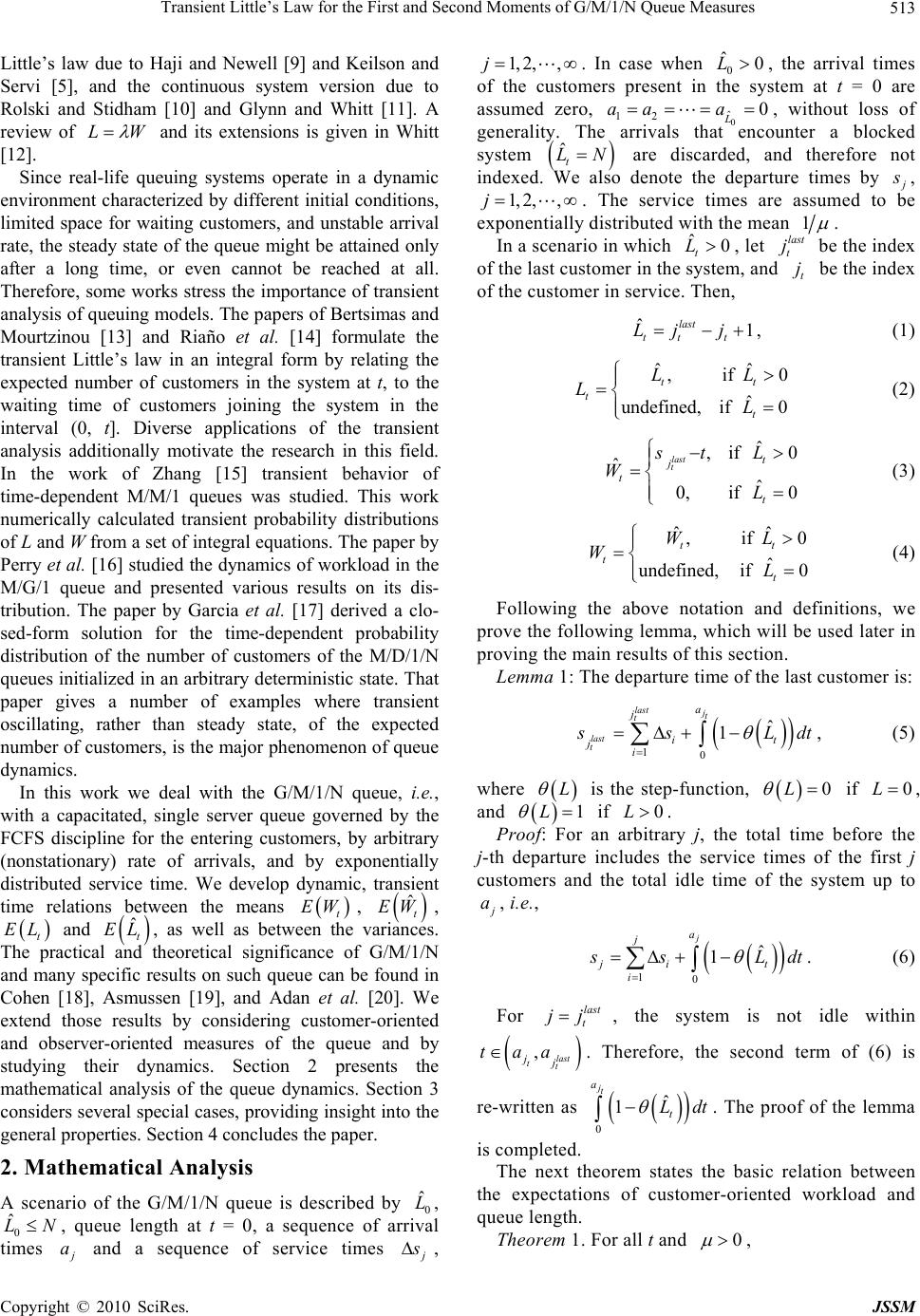 Transient Little’s Law for the First and Second Moments of G/M/1/N Queue Measures513 Little’s law due to Haji and Newell [9] and Keilson and Servi [5], and the continuous system version due to Rolski and Stidham [10] and Glynn and Whitt [11]. A review of LW and its extensions is given in Whitt [12]. Since real-life queuing systems operate in a dynamic environment characterized by different initial conditions, limited space for waiting customers, and unstable arrival rate, the steady state of the queue might be attained only after a long time, or even cannot be reached at all. Therefo re, some works str ess the importance of transient analysis of queuing models. The papers of Bertsimas and Mourtzinou [13] and Riaño et al. [14] formulate the transient Little’s law in an integral form by relating the expected number of customers in the system at t, to the waiting time of customers joining the system in the interval (0, t]. Diverse applications of the transient analysis additionally motivate the research in this field. In the work of Zhang [15] transient behavior of time-dependent M/M/1 queues was studied. This work numerically calculated transient probability distributions of L and W from a set of integral equations. The paper by Perry et al. [16] studied the dynamics of workload in the M/G/1 queue and presented various results on its dis- tribution. The paper by Garcia et al. [17] derived a clo- sed-form solution for the time-dependent probability distribution of the number of customers of the M/D/1/N queues initialized in an arbitrary deterministic state. That paper gives a number of examples where transient oscillating, rather than steady state, of the expected number of customers, is the major phenomenon of queue dynamics. In this work we deal with the G/M/1/N queue, i.e., with a capacitated, single server queue governed by the FCFS discipline for the entering customers, by arbitrary (nonstationary) rate of arrivals, and by exponentially distributed service time. We develop dynamic, transient time relations between the means , t EW ˆt EW , and , as well as between the variances. The practical and theoretical significance of G/M/1/N and many specific results on such queue can be found in Cohen [18], Asmussen [19], and Adan et al. [20]. We extend those results by considering customer-oriented and observer-oriented measures of the queue and by studying their dynamics. Section 2 presents the mathematical analysis of the queue dynamics. Section 3 considers several special cases, providing insight into the general properties. Section 4 concludes the paper. t EL ˆt EL 2. Mathematical Analysis A scenario of the G/M/1/N queue is described by 0, 0, queue length at t = 0, a sequence of arrival times ˆ L ˆ LN j a and a sequence of service times j s , 1, 2,,j . In case when 0, the arrival times of the customers present in the system at t = 0 are assumed zero, 0 ˆ 12 L ˆ0L 0aaa , without loss of generality. The arrivals that encounter a blocked system N ˆt L are discarded, and therefore not indexed. We also denote the departure times by j s , 1, 2,,j . The service times are assumed to be exponentially distributed with the mean 1 . In a scenario in which t, let be the index of the last customer in the system, and be the index of the customer in service. Then, ˆ L ˆlast tt Lj 0 1 t j last t j t j ˆˆ ,if ˆ if 0 t LL L ˆ ,i f ˆ if t t L , (1) 0 t undefined, t ˆ 0, last t j t st L W t L (2) 0 0 f undefine t 10 last jt t st a j i (3) ˆˆ ,i ˆ d, if t t WL L ˆ 1 i 0 0 t W la t j (4) Following the above notation and definitions, we prove the following lemma, which will be used later in proving the main results of this section. Lemma 1: The departure time of the last customer is: t s s L dt, (5) where L is the step-function, if 0L 0L , and 1L if . 0L Proof: For an arbitrary j, the total time before the j-th departure includes the service times of the first j customers and the total idle time of the system up to j a, i.e., ˆ 1 10 j a j ji it s s t Ldt . (6) For , the system is not idle within las t jj ,last tt jj taa. Therefore, the second term of (6) is re-written as . The proof of the lemma is completed. ˆ 1 jt t L dt 0 0 a The next theorem states the basic relation between the expectations of customer-oriented workload and queue length. Theorem 1. For all t and , Copyright © 2010 SciRes. JSSM 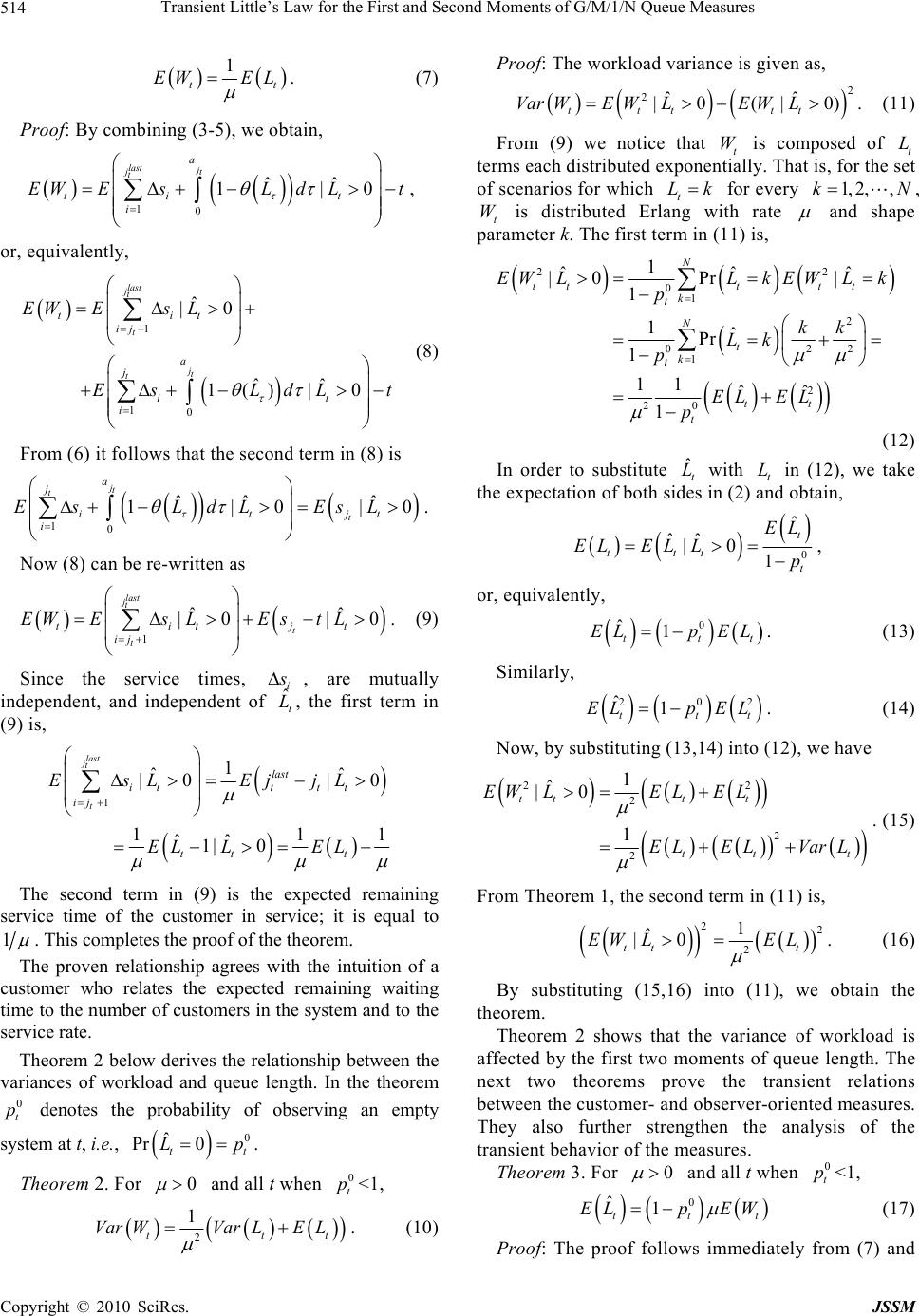 Transient Little’s Law for the First and Second Moments of G/M/1/N Queue Measures 514 1 t EW EL t t 0 jt t . (7) Proof: By combining (3-5), we obtain, 10 ˆˆ 1|0 last j jt t a ti t i EWEsLd Lt , or, equivalently, 1 10 ˆ |0 ˆˆ 1() |0 last jt t jt t tit ij a j it i EWEs L Es LdL (8) From (6) it follows that the second term in (8) is 10 ˆˆ ˆ 1|0| jt t t a j it i EsLdLEsL . Now (8) can be re-written as 1 ˆˆ |0 |0 last jt t t titj ij EWEsLEst L . (9) Since the service times, i s ˆt L, are mutually independent, and independent of , the first term in (9) is, 1 1 ˆˆ |0 |0 11 ˆˆ 1| 0 last jt t last itt tt ij tt t EsL EjjL EL LEL 1 The second term in (9) is the expected remaining service time of the customer in service; it is equal to 1 . This completes the proof of the theorem. The proven relationship agrees with the intuition of a customer who relates the expected remaining waiting time to the number of customers in the system and to the service rate. Theorem 2 below derives the relationship between the variances of workload and queue length. In the theorem denotes the probability of observing an empty system at t, i.e., . 0 t p 0 ˆ Pr 0 tt Lp Theorem 2. For 0 and all t when <1, 0 t p 2 1 tt Var WVarLEL Proof: The workload variance is given as, 2 2ˆˆ |0 (|0) ttttt VarWEWLE WL. (11) From (9) we notice that t W is composed of t terms each distributed exponentially. That is, for the set of scenarios for which t L Lk for every 1, 2,,kN , t is distributed Erlang with rate W and shape parameter k. The first term in (11) is, 22 01 2 02 1 2 20 1 ˆˆ |0 Pr| 1 1ˆ Pr 1 11 ˆˆ 1 N ttt tt k t N t k t tt t EW LLkEW Lk p kk Lk p EL EL p 2 ˆ (12) In order to substitute with t in (12), we take the expectation of both sides in (2) and obtain, ˆt L L 0 ˆ ˆˆ |0 1 t ttt t EL ELEL Lp , or, equivalently, 0 ˆ1 tt ELp EL t . (13) Similarly, 20 ˆ1 tt ELp EL2 t . (14) Now, by substituting (13,14) into (12), we have 22 2 2 2 1 ˆ |0 1 ttt t tt EW LELEL EL ELVarL t . (15) From Theorem 1, the second term in (11) is, 22 2 1 ˆ |0 tt t EW LEL . (16) By substituting (15,16) into (11), we obtain the theorem. Theorem 2 shows that the variance of workload is affected by the first two moments of queue length. The next two theorems prove the transient relations between the customer- and observer-oriented measures. They also further strengthen the analysis of the transient behavior of the measures. Theorem 3. For 0 and all t when <1, 0 t p 0 ˆ1 tt ELp EW t (17) t . (10) Proof: The proof follows immediately from (7) and Copyright © 2010 SciRes. JSSM 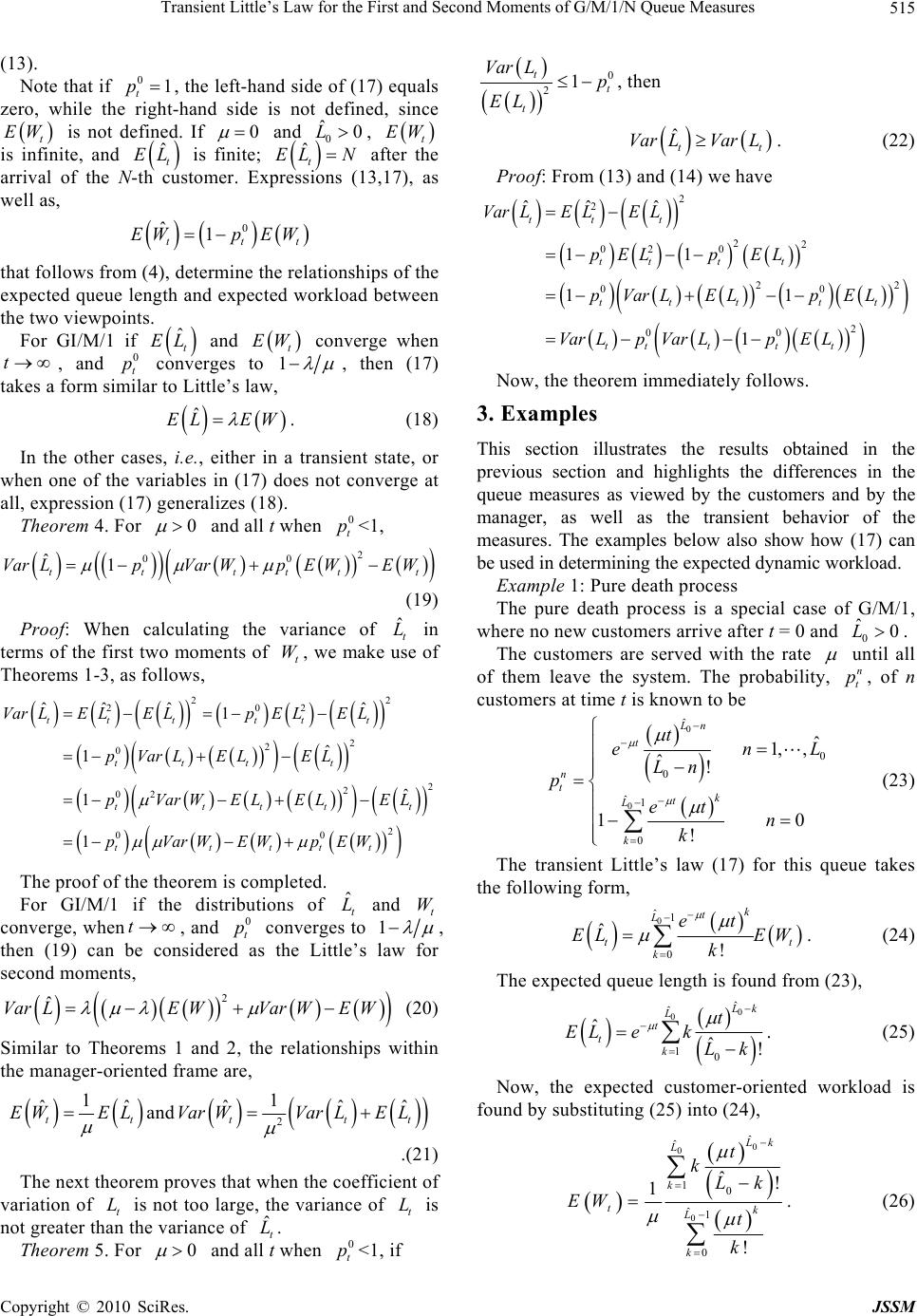 Transient Little’s Law for the First and Second Moments of G/M/1/N Queue Measures515 (13). Note that if , the left-hand side of (17) equals zero, while the right-hand side is not defined, since is not defined. If 01 t p t EW 0 and , 0 ˆ0L t EW is infinite, and is finite; after the arrival of the N-th customer. Expressions (13,17), as well as, ˆt EL tN ˆ EL 0 ˆ1 tt EWpEWt that follows from (4), determine the relationships of the expected queue length and expected workload between the two viewpoints. For GI/M/1 if and converge when , and converges to ˆt EL t EW t 0 t p1 , then (17) takes a form similar to Little’s law, ˆ EL EW . (18) In the other cases, i.e., either in a transient state, or when one of the variables in (17) does not converge at all, expression (17) generalizes (18). Theorem 4. For 0 and all t when <1, 0 t p 2 00 ˆ1 ttttt VarLpVarWp EWEW t (19) Proof: When calculating the variance of te ˆ in t L rms of the f irst two moments of t W, we make use of Theorems 1-3, as follows, 0 2 2 2 0 2 2 02 2 00 ˆˆ ˆˆ 1 ˆ 1 ˆ 1 1 tt ttt t ttt t tttt ttttt VarLELELp ELEL pVarL ELEL pVarWELEL EL pVarWEWpEW 2 22 t The proof of the theorems completed. For GI/M/1 if the disibutions of and co i tr ˆt L s tot W nverge, whent, and 0 p converge t 1 , forth Similar to Theorems 1 and 2, the relationships w the manager-oriented frame are, en (19) can be considered as the Littl law second moments, 2 ˆ VarLE WVar WE W (20) e’s ithin 1 ˆˆ tt EW EL and 2 1 ˆˆˆ t Var W tt Var LE L .(21 The next theorem proves that when the coefficient variation of is not too large, the variance of no ) of L is t t t greater than the variance of ˆt L. Theorem 5. For 0 L and all t when 0 t p<1, if 0 21 tt p Var L , then t EL ˆtt Var L.Var L (22) Proof: From (13) and (14) we have ˆˆ ˆ tt t r LE LE L 2 2 22 02 0 22 00 2 00 11 11 1 tt t t ttt tt tttt t Va pELp EL pVarLELpEL Var LpVar LpEL Now, the theorem immediately follows. 3. ustrates the results obtained in the and highlights the differences in the , wt = 0 and . Examples This section ill previous section queue measures as viewed by the customers and by the manager, as well as the transient behavior of the measures. The examples below also show how (17) can be used in determining the expected dynamic workload. Example 1: Pure death process The pure death process is a special case of G/M/1 here no new customers arrive after 0 The customers are served with the rate ˆ0 L until all of them leave the system. The probability, n n t p, of customers at time t is known to be 0 ˆ ˆ Ln tt en 0 0 0 ˆ1 0 ˆ 1, , ! 10 ! n tk t L k L Ln p et n k (23) The transient Little’s law (17) for this queue takes the following form, 0 ˆ1 ˆk t L t et EL 0!t k EW k . (24) The expected queue length is found from (23), 0 0 ˆ ˆˆ 10 ˆ! L k L t t t EL ek . kLk (25) Now, the expected customer-ori found by substituting (25) into (24), ented workload is 0 0ˆ ˆ 0 10 ˆ1 0 ˆ! 1 ! L k Lt k k tk L k Lk EW t k . (26) Copyright © 2010 SciRes. JSSM  Transient Little’s Law for the First and Second Moments of G/M/1/N Queue Measures 516 When t , , 1 t EL , ˆ0 t EL 1 t EW intuition regard and supports the i death process. Similarly, the customer-oriented workload variance is calculated from (10), t EW ng the time-lim 0, which it behavior of the pure 0 0 0 2 ˆ ˆ ˆ2 10 ˆ! ˆ ()! 11 Lk L L k t tk kLk Lk Var W 0 0 0 0 ˆ 10 0 ˆ ˆ 10 2ˆ1 0 !! ˆ! 1 ! Lk k k Lk L k k L k kk t kLk t k (27) When and 00 22 ˆˆ 11 0 tkk LL k tt t, 0 t Var L 2 1 t Var W . Example on of D/M/1/N The customers arrive with fixed interarrival times equal to 2: Numerical simulati 14 ic and served with exponentially distributed serve times with the mean 145 . The eue initial queue length is 4, and the capacity of the qu is . In rning the sim code, we hav estning w). asures’ m infiniteunulatione imated the queue length measures. The remai aiting time measures have been calculated from (7), (10) and (21 Figure 1 presents the plots of the meeans, t EL , ˆt EL , t EW and ˆt EW . Figure 2 presents the plots of the measures’ variances, t Var L, ˆt Var L, t Var W and ˆt Var W. This experiment shows that the perception of the dynamic behavior of a queue can differ significant t converge in ly whether th (from the e manager or the queue does no customers are required to assess it. The simulated time manager’s viewpoint) in spite of low utilization omve theent behavior with low variability of the queue measures. The next experiment illustrates queue behavior when the arrival rate is higher than the service rate, 1.9, 1.3 , while the custers obser converg , 0 ˆ8, 14 LN. Since the probability of observing an empty queue is alwayso zero, both the manager and customers measures almost coincide. Therefore, Figures 3 and 4 close t present only the cu Little’s law, i. stomers measures. Figure 5 compares t EW with the expected waiting time, which would follow from e., 14 t p. A significant deviation between the last two expected waiting time measures can be noticed. For example, at t = 39, ˆ1 t EL ˆ13.185 tt EL EL, the expected waiting time of the last customer is estimated by t EW 0.142, while the estimation made b e as 1 y th 14 ˆ1 tt p measure is 16.662. Therefore, the EL 14 ˆ1 tt EL p measure significantly over-estimates the expected wait- ing time in this case. gure 1. t EL - thin line, ˆt ELFi - bold li t EWne, - thin dashed line , and ˆt EW - bold dashed line. gure 2. t Var L- thin line, - bold line, ˆt Var L t W- thin dashed line Fi Var ˆt W- bo, and Var ld dashed line. Copyright © 2010 SciRes. JSSM 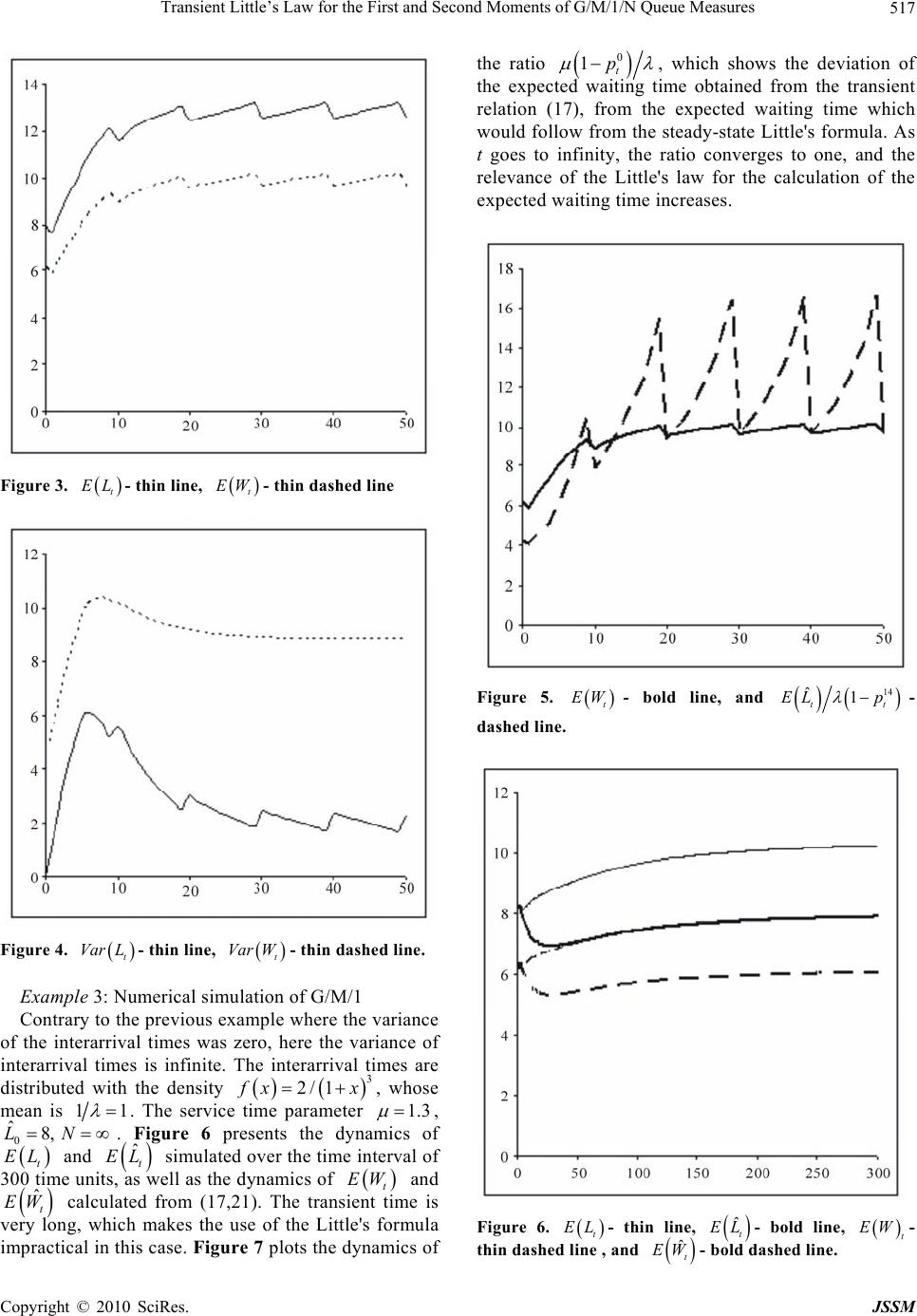 Transient Little’s Law for the First and Second Moments of G/M/1/N Queue Measures517 Figure 3. t EL - thin line, t EW - thin dashed line Figure 4. - thin line, t Var L t Var W- thin dashed line. e 3: Nmulati Contr ary to the previous example where the variance f the interarrival times was zero, here the variance of interarrival times is infinite. The interarrival times are distributed with the density Exampl umerical sion of G/M/1 o 3 2/ 1 f xx, whose mean is 11 . The service time parameter 1.3 , ics of erval of 0 ˆ8,LN t EL and 300 time unit . Figure 6 p simula l as th resents the dynam ted over the time int e dynamics of ˆt EL s, as wel t and ent time is mula EW The transi se of the Little's for ˆt EW calculated very long, whfrom (17,21). kes the u impractical in this case. Figure 7 plots the dynamics of the ratio ich ma 0 1t p the expected waiting tim m ow from the st infinity, th he Littl waiting time , which shows the deviation of e obtained from the transient relation (17), frothe expected waiting time which would folleady-state Little's formula. As t goes toe ratio converges to one, and the relevance of te's law for the calculation of the expected increases. Figure 5. t EW - bold line, and 14 ˆtt EL p - line. 1 dashed - thin line, ˆt EL t EL - bold line, t EW Figure 6.- thin dasheand d line , ˆt EW - bold dashed line. Copyright © 2010 SciRes. JSSM 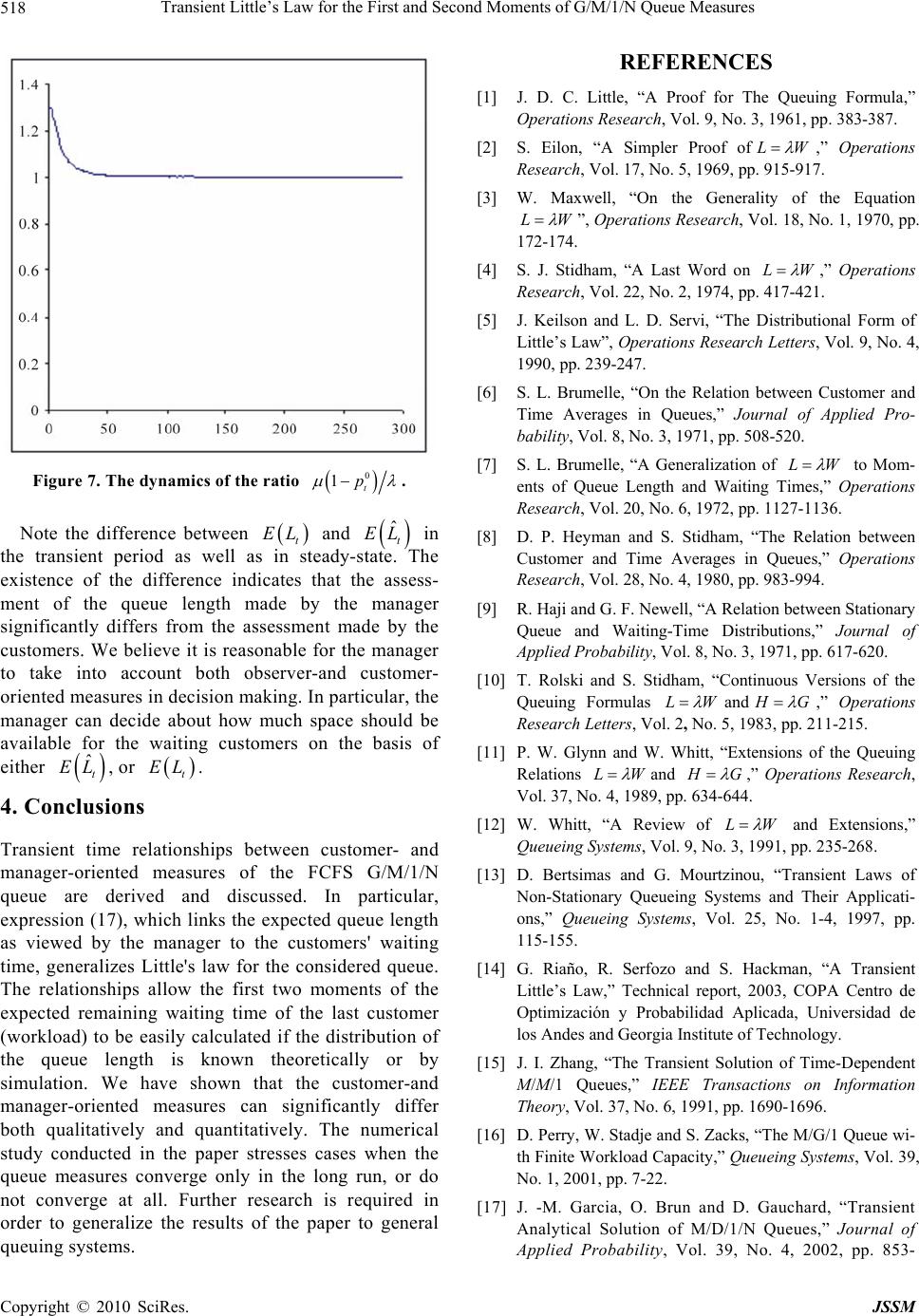 Transient Little’s Law for the First and Second Moments of G/M/1/N Queue Measures 518 Figure 7. The dynamics of the ratio 0 1t p . Note the difference between and t EL ˆt EL tate. Th asse manag ade by the the manager custom ticular, the space should the basis of in t period as well eady-se istence of the difference ind that thess- ment of the queue length mde by the er significantly differs from the assnt m customers. We believe it is ree for to take into account both r-and er- oriented measures in decision mIn par manager can decide about how be available for the waiting custo either , or 4. Conclusions Transient time relationships between customer- and manager-oriented measures of the FCFS G/M/1/N queue are derived and discussed. In particular, expression (17), which links the expected queue length as viewed by the manager to the customers' waiting time, generalizes Little's law for the considered queue. The relationships allow the first two moments of the expected remaining waiting time of the last customer lated is kn or by simulation. We have shown that the customer-and manager-oriented measures can significantly differ both qualitatively and quantitatively. The numerical study conducted in the paper stresses cases when the queue measures converge only in the long run, or do not converge at all. Further research is required in order to generalize the results of the paper to general queuing systems. REFERENCES [1] J. D. C. Little, “A Proof for The Queuing Formula,” Operations Research, Vol. 9, No. 3, 1961, pp. 383-387. [2] S. Eilon, “A Simpler Proof o th exe transienas in st icates aessme asonabl observe aking. much mers on ˆt EL t EL . (workload) to be easily calcuif the distribution of the queue length own theoretically f L W ,” Operations Research, Vol. 17, No. 5, 1969, pp. 915-917. [3] W. Maxwell, “On the Generality of the Equation L W ”, Operations Research, Vol. 18, No. 1, 1970, pp. 172-174. [4] S. J. Stidham, “A Last Word on L W ,” Operations Research, Vol. 22, No. 2, 1974, pp. 417-421. [5] J. Keilson and L. D. Servi, “The Distributional Form of Little’s Law”, Operations Research Letters, Vol. 9, No. 4, 1990, pp. 239-247. [6] S. L. Brumelle, “On the Relation between Customer and Time Averages in Queues,” Journal of Applied Pro- bability, Vol. 8, No. 3, 1971, pp. 508-520. [7] S. L. Brumelle, “A Generalization of L W to Mom imes,” Operations Research, Vol. 20, No. 6, 1972, pp. 1127-1136. [8] , “Then betw - ents of Queue Length and Waiting T D. P. Heyman and S. Stidham Relatioeen Customer and Time Averages in Queues,” Operations Research, Vol. 28, No. 4, 1980, pp. 983-994. [9] R. Haji and G. F. Newell, “A Relation between Stationary Queue and Waiting-Time Distributions,” Journal of Applied Probability, Vol. 8, No. 3, 1971, pp. 617-620. [10] T. Rolski and S. Stidham, “Continuous Versions of the Queuing Formulas L W and HG ,” Operations Research Letters, Vol. 2, No. 5, 1983, pp. 211-215. [11] P. W. Glynn and W. Whitt, “Extensions of the Queuing Re lations L W and HG ,” Operations Research, 989, pp. 634-644. Vol. 37, No. 4, 1 [12] W. Whitt, “A Review of L W and Extensions,” bility, Vol. 39, No. 4, 2002, pp. 853- Queueing Systems, Vol. 9, No. 3, 1991, pp. 235-268. [13] D. Bertsimas and G. Mourtzinou, “Transient Laws of Non-Stationary Queueing Systems and Their Applicati- ons,” Queueing Systems, Vol. 25, No. 1-4, 1997, pp. 115-155. [14] G. Riaño, R. Serfozo and S. Hackman, “A Transient Little’s Law,” Technical report, 2003, COPA Centro de Optimización y Probabilidad Aplicada, Universidad de los Andes and Georgia Institute of Technology. [15] J. I. Zhang, “The Transient Solution of Time-Dependent M/M/1 Queues,” IEEE Transactions on Information Theory, Vol. 37, No. 6, 1991, pp. 1690-1696. [16] D. Perry, W. St adje and S. Zack s, “The M/G/1 Que ue wi- th Finite Workload Capacity,” Queueing Systems, Vol. 39, No. 1, 2001, pp. 7-22. [17] J. -M. Garcia, O. Brun and D. Gauchard, “Transient Analytical Solution of M/D/1/N Queues,” Journal of Applied Proba Copyright © 2010 SciRes. JSSM 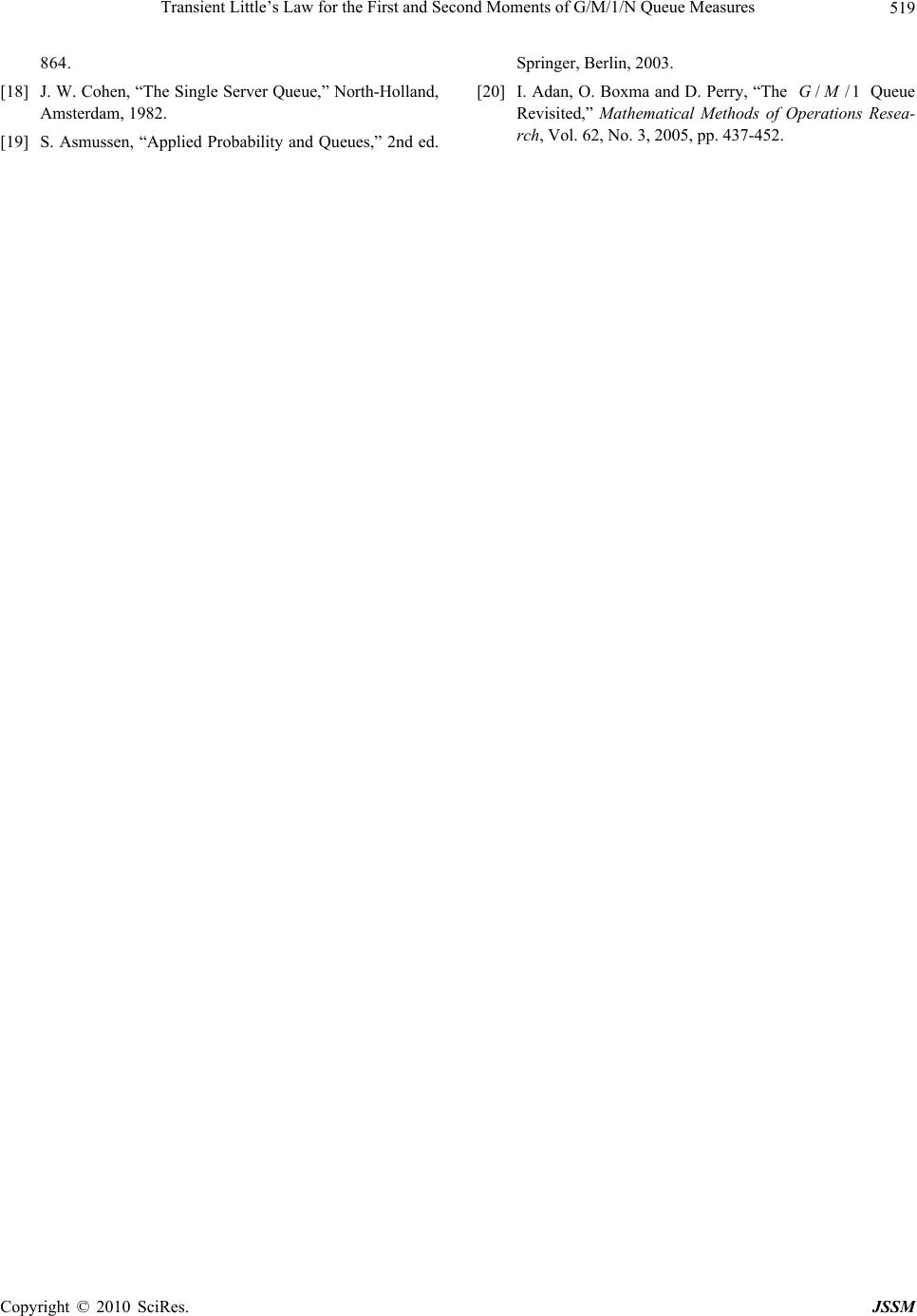 Transient Little’s Law for the First and Second Moments of G/M/1/N Queue Measures Copyright © 2010 SciRes. JSSM 519 864. The Queue Springer, Berlin, 2003. [20] I. Adan, O. Boxma and D. Perry, “//1GM [18] J. W. Cohen, “The Single Server Queue,” North-Holland, Amsterdam, 1982. Revisited,” Mathematical Methods of Operations Resea- rch, Vol. 62, No. 3, 2005, pp. 437-452. [19] S. Asmussen, “Applied Probability and Queues,” 2nd ed. |

